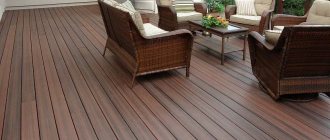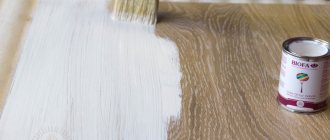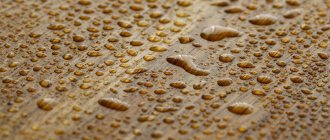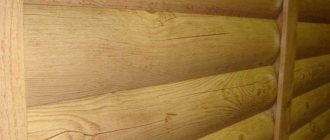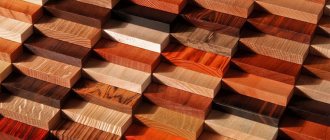Just a piece of advice: before starting work, assess the condition of the wood - it is effective to treat wood with a humidity of up to 25%.
Products that are actually suitable for wood processing
“Record holders” in terms of protecting wood from mold and bugs are wax and oil. They historically have the highest results:
- increasing the strength of wood fiber;
- improvement of appearance (even parquet and expensive oak furniture are impregnated with oil);
- extension of service life;
- protection against mold and other biological damage;
- harmless to humans, do not emit caustic volatile compounds;
- have a pleasant smell;
- if scratches appear on the wood, then it is enough to treat it with oil again and rub this area, and it will become as good as new, that is, wood impregnated with oil is repairable;
- low cost and ease of operation.
Impregnating oils are also good because, despite the natural composition, they are an excellent antiseptic. In addition, oils make the surface of the log house more elastic, which means there is a chance to minimize the number of cracks during shrinkage.
But the most important thing: impregnation with oil and wax does not “kill” the best qualities of wood - environmental friendliness and the ability to “breathe”. Chemical compounds such as machine oil completely clog the pores of wood, so there can be no talk of any “breathing” house with an ideal climate.
The most popular among Russian owners are flaxseed, sunflower and tar oils. There are also “exotics” - tung and teak, but they are more expensive, and the quality is not very different from the budget options.
A clear example of how wood is refreshed when treated with linseed oil, and subsequent waxing will give the floor a matte finish and hide scratches
Let's take a closer look at popular oils. Which one suits you, and whether it suits you at all, judge for yourself.
Type of oil
| Meaningful quality | Compound | Where is it used? | Texture, color | Can it be diluted? | How long does it take to dry? | Consumption | |
| Degtyarnoe | A strong antiseptic – the oil can protect even the bottoms of piers and boats; protects against moisture, bugs, rot | Stump resin, linseed oil (holds the composition inside the wood) and turpentine (penetrates well into the wood) | In everyday life it is suitable for impregnation of log buildings, garden furniture and outbuildings | Gives wood a transparent texture | No | Up to 7 days | 150 ml per 1 sq. m of sanded surface; for log walls - 1 liter per 10 sq. m |
| Linen | Strong waterproofing agent, suitable for interior and exterior decoration | Linoleic and linolenic acid penetrate even the smallest cracks, thicken and create a durable moisture-proof layer | Impregnation of facades, ceilings and walls, trim, furniture, small wooden objects | Reveals wood texture | Yes - tar, wax, turpentine | Up to 20 days | 100-200 g per 1 sq. m depending on the texture and relief of the wood |
Important: the oil will also help if the wood is already damaged by a bug. To do this, old craftsmen advise pouring tar oil into each hole with a syringe, and then sealing the holes with sealant. Thanks to the oil, the beetle will die, but if the holes are left, the woodworms will return next year. The technique perfectly stops the process of wood being corroded by bugs, preserves the wood and extends its service life by at least 15 years.
Surface oil impregnation
When building your own home, protective oil is used to treat walls and other wooden structures; this operation can be performed independently. Oil impregnation penetrates into wood more deeply than varnish or paint, and does not form a surface film; the advantages of this treatment are:
- Wood capillaries are sealed and do not absorb atmospheric moisture,
- The wood structure is protected from the penetration of fungal spores, the use of oil eliminates the use of antiseptics,
- The texture becomes more pronounced, the surface acquires a soft shine, better results are achieved when processing glued material,
- The effect of “open pores” is preserved.
Structures made from chamber-dried profiled timber are treated with an impregnating reagent immediately after laying the walls; a log frame made from edged lumber of natural moisture is treated after shrinkage and applied to a sanded surface. It must be taken into account that the oil evaporates, is oxidized by atmospheric oxygen, destroyed by solar ultraviolet radiation, and the operation is repeated periodically. Manufacturers have developed multi-component impregnating compositions with increased service life.
The nuances of waxing
Another popular ingredient is wax. It is also good, but it has a significant drawback - it is only suitable for interior decoration, since it does not tolerate high temperatures, heat and is easily removed from the surface.
In modern house construction, only wooden floors are treated with wax, since waxing is a long and painstaking job that requires subsequent rubbing of the surface with oil. The materials can be either self-made (molten wax and then linseed oil) or factory-made (now they are produced by manufacturers from the USA, Germany and Turkey). All this is expensive and difficult, so it is advisable to treat parquet and expensive furniture with wax.
Impregnation procedure and conditions
The most common method is rubbing into the surface. It is suitable for linseed, mineral oil. You need to rub the oil into the wood using sandpaper (P400) and a cloth napkin. The procedure should be carried out 3-4 times. After each time, the oil should be absorbed, i.e. surface is dry. This will take 3-8 days. A rag is needed for the initial application, as well as in the final stage - sanding. In exchange for long processing, you will get excellent results.
The second method is lubrication. It is used only when the wood will be subsequently coated with paint. The oil is applied with a regular brush. It is important that it be a drying oil, for example, linseed. Then the surface is leveled with a beige pad or cotton cloth.
The last 2 methods are boiling and soaking. For technical reasons, they are suitable only for small items: pens, toys. To soak, place the product in a pan and leave it covered for a couple of days. After this, sand with a cloth until shiny.
You can boil it, then the time is reduced to 1 day. Boiling is carried out over low heat at a certain temperature, depending on the oil (see table below).
Used machine oil
Used engine oil is the most popular “impregnation” option that is at hand. Actually, it became popular precisely because there was practically no alternative. Previously, people valued “working out”: it really works as an antiseptic, protects against rodents and moisture. But no matter how profitable and convenient this option may be, we cannot help but mention its negative impact on wood and your health:
- It smells terrible. According to experienced owners, such oil can exude a “fragrance” for up to a year until it completely dries out.
- It releases volatile compounds that are dangerous to humans, so it can only be used in non-residential premises.
Machine oil can be used to treat wooden parts in a garage, a house for storing equipment, parts close to the ground (foundation, plinth and fences). But in the same barn where the cattle live, you cannot use “working off”.
- Wood loses color and texture.
- This oil is highly flammable. Wood itself is a combustible material, and “processing” enhances this quality.
- It is difficult to paint wood after machine oil - the paint does not adhere.
If you decide to use machine oil, choose formulations with mineral properties - this is less destructive and harmful to both the tree and you.
After treatment with machine oil, wood loses color, texture and visually ages
Processing wood with transformer oil: pros and cons
Introduction: The struggle for an environmentally friendly environment in everyday life, which actively unfolded at the beginning of the 21st century, has greatly changed the direction of development and innovation in industry, forced to comply with both the growing demand for environmentally friendly products and the strict requirements for raising standards, dictated by the need to stop pollution of the planet.
In view of the widespread use of wood in the domestic and industrial spheres, antiseptics and impregnation methods are different to ensure the environmental safety of the domestic sphere on the one hand, but, on the other hand, to make it possible to preserve wooden structures and industrial products for as long as possible by preventing excessive cutting down of trees that provide the planet with clean air .
Popular substances for impregnation
Popular “folk remedies” include:
- clay coating;
- copper, iron sulfate;
- drying oil
Let's take a closer look at them. The first is a protective layer of clay, ordinary salt and water. This composition is coated with a 2 mm layer of wood. There is also an option for a mixture of superphosphate and water, which is applied to the wood in a layer of 3 mm.
This coating really protects against external influences and helps the tree maintain its integrity. There is only one question - who would want to coat the beautiful facade of a house or an elegant wooden gazebo with clay? And even more so the wooden walls from the inside of the house?
This option is only suitable for outbuildings, such as a barn. And, in general, this was relevant on the scale of active construction of state and collective farms in Soviet times, and aesthetics and durability were always in question.
Another method is to treat wood with copper or iron sulfate. These are metal salts that work well as antiseptics. But vitriol is dangerous to health: if it comes into contact with the skin, eyes, or nose, it leads to choking, coughing, abdominal pain, swelling and lacrimation. If the wood treated with it begins to burn, the inhaled combustion products will lead to serious burns of the mucous membranes. Such impregnation is unsafe for humans.
And you shouldn’t use vitriol as a façade finish either:
- It makes the wood darken and turn gray. If you want to leave the natural texture and color, then this composition will ruin everything. Vitriol, of course, will not work for facades, gazebos, or staircases in the house.
- If there are galvanized metal parts, then the vitriol will “remove” the zinc layer.
- You cannot work with vitriol in wet weather, and for a couple of days after “painting” it should be dry and warm.
- In rainy weather, such a wall will be “smeared”.
The vitriol mixture is good for “technical” boards, such as beams and joists (when installing a roof or laying a floor). That is, these can be elements hidden from view, where aesthetics, color and texture are not important, but integrity, invulnerability and durability are significant.
Copper sulfate is a good tool for treating sheathing or joists, that is, elements of the house hidden from view
Even more often, wood is treated with drying oil, arguing that it is natural linseed oil.
Indeed, in theory, technical linseed oil is considered drying oil. However, in stores, bottles labeled “Drying Oil” often sell a mixture of synthetic and vegetable oils.
This composition is worse than natural linseed oil. He:
- dries poorly and does not form a durable film;
- clogs wood pores - does not allow the wood to “breathe”, increases the risk of mold due to mustiness inside the log house;
- often contains lead compounds, so surfaces in residential areas cannot be treated with this composition.
Therefore, drying oil from the store is far from the best option for impregnation. It is suitable for treating garden furniture, fences, technical buildings for further painting. If you are planning to impregnate the facade or walls of your house, then carefully read the composition, look for technical linseed oil, or simply buy edible linseed oil in the supermarket and work with it.
Application technologies, features and nuances
It is important not only to choose the right oil for wood processing, but also to use it correctly. Then the protective layer will be durable and will not lose its properties.
It is important not only to choose the right oil for wood processing, but also to use it correctly.
Preparatory work
Preparation begins with inspecting the surface for defects; if large defects larger than 5 mm are identified, they are eliminated. Afterwards, the product is sanded, cleaned of dirt and a primer solution is applied.
There are solutions that do not require the application of a primer; you can read about this on the packaging.
Preparation begins with inspecting the surface for defects; if large defects larger than 5 mm are identified, they are eliminated.
Algorithm for applying oil
When the primer layer dries, proceed to saturating the surface with oil products. Typically, the tool of choice is rollers and brushes. To avoid the formation of strong smudges, apply the composition along the fibers. It is acceptable to use fabric swabs to treat the surface with the composition.
To avoid the formation of strong smudges, apply the composition along the fibers.
Impregnation technologies
According to the working technology, you can choose from two methods: coating and soaking. The second technique can be performed only when working with small products. For large ones it will be difficult to find a suitable container.
According to the working technology, you can choose from two methods: coating and soaking.
Preliminary stage
With any method, they begin by removing the old layer, if any. The wooden base is sanded, cleaned of dirt and primed if necessary. Primers serve to improve adhesion and reduce material consumption.
Primers serve to improve adhesion and reduce material consumption.
Coating
Using a brush with natural wax or a soft cloth soaked in oil, treat the entire surface with the first layer. After 15-20 minutes, excess parts of the product are removed. After drying, apply a second layer of impregnation.
Using a brush with natural wax or a soft cloth soaked in oil, treat the entire surface with the first layer.
Soaking
Soaking helps to get good soaking. Oil is poured into the selected container, into which the item that needs soaking is placed. It can remain in it for a long time; the release of bubbles can serve as a guide to the completion of the process.
Soaking helps to get good soaking.
Number of layers
Usually 2-3 layers of the substance are applied. Here it is better to look at the instructions from the manufacturer, and the condition of the surface; if it has deeply absorbed the product, then another layer is needed.
Usually 2-3 layers of the substance are applied.
Drying time
It takes at least a day for the composition to dry completely. For this reason, driers are often used to reduce the time. It is advisable to refer to the manufacturer's instructions to determine the drying time for a particular substance.
It takes at least a day for the composition to dry completely.
Consumption
To calculate consumption, you need to know the area of the surface being treated and the average consumption indicated on the packaging. The average consumption is 100 g/m2. If wax is present in the impregnation, then less substance may be needed - 75 g/m2.
The average consumption is 100 g/m2.
How to dilute
Finished products are rarely diluted, they are produced in the required consistency, they are thoroughly mixed before use and that’s it. But some tree species must be treated with more liquid substances. You can add turpentine, other oil, white-spirit.
Finished products are rarely diluted, they are produced in the required consistency, they are thoroughly mixed before use and that’s it.
Wood treatment oil will help to obtain a reliable layer from moisture and other factors. But it is important to choose an acceptable option for specific working conditions. The article described the characteristics of the species, they should help make the right choice.
What to prefer?
Of course, the ideal option is to purchase special antiseptic moisture-proof impregnations for wood from a reliable manufacturer. Factories produce the same natural oils with additives that improve the properties of the product.
We will give some recommendations for choosing store-bought impregnation:
- All wood impregnations that are put on the market must comply with BPD (Bioceds Product Directive) standards, that is, they must be biologically pure, environmentally friendly products. Not all domestic manufacturers have such a certificate, but you can also take a closer look at those products that do not have such a guarantee. True, there are risks in terms of service life.
- For wood, it is better to purchase acrylic impregnations and water-based compounds - they will give the wood the opportunity to “breathe”. Rough solvents clog pores and, in fact, create a risk of rotting.
Wood impregnations have a standard line: there are compositions that prepare wood for transportation, mixtures for primary and secondary processing (when the wood is already varnished), as well as fire-retardant impregnations and antiseptics.
What is it for
Note. The main goal that is achieved in the final result when wood impregnating oil is used is to extend the life of the product.
The knife handle is treated with linseed oil
- Let's start with the fact that impregnating wood with waste oil, or even better - linseed oil, is much more effective than opening it with varnish, since the varnish can crack and water will definitely penetrate into the cracks, moreover, it wears off very quickly under mechanical stress. In addition, the structure of wood treated with oil does not change, for example, if it is the handle of a knife or the butt of a rifle, then they will not slide - the slight roughness inherent in wood will remain on them. Oiled products have a soft shine that does not go away over time, even with partial abrasion – the fact is that the composition penetrates quite deeply and constant sanding from the touch of hands will not harm it in any way. In addition, the instructions recommend treating the wood with various antiseptics, but in this case this is not necessary, since the impregnation tightly clogs all pores and the formation of microorganisms , causing mold and rot.
A folk remedy invented by scientists
If you really want to make impregnation yourself, you should turn to proven methods. In Soviet times, in the Senezh Wood Conservation Laboratory of the TsNIIMOD Ministry of the Forestry and Woodworking Industry of the USSR (yes, it’s a long read), a safe composite “BB-11” was developed - it is harmless to humans, protects against biological damage and does not change the color of wood, since it was originally developed for restoration valuable wooden objects in Karelia. It is prepared as follows:
- 173 g of technical borax;
- 173 g boric acid;
- 3,094 liters of water.
This is a composition for processing 1 square. m. From a mixture of borax salts and acid, you need to prepare a 10% aqueous solution, and before application, heat it to 40 0C. Apply the mixture to the wood with a soft brush, either seven times, or after a single application, cover the treated surface with polyethylene, securing it with push pins. Of course, if this is a facade, you won’t have enough polyethylene; you will have to process it in seven layers (you don’t need to wait for the previous layer to dry). This product meets all the requirements and at the same time can be considered a “folk” recipe.
Which oil should you choose?
Each type of work is characterized by the choice of oil that is most suitable for its implementation. Let's look at each type of work and oils for them in more detail.
For outdoor use
When carrying out external work, the master must focus on the thickness and texture of the wood and the effect that he is trying to achieve.
If there is a desire to give the surface additional tint, it is recommended to use matte linseed oil.
Such impregnations are produced in various shades, from natural to rich colors. In addition, flaxseed oil has high protection against bacteria.
.
This criterion is important when choosing a coating, because wood on the outside of a building is most susceptible to external influences from insects and various types of fungi.
For additional protection of wood during external work, it is recommended to use antiseptic impregnation “Vinha” from the Tikkurila Vinha brand.
. It will provide long-term protection against wet drops and mold development.
For interior work
It is best to carry out work on indoor walls using Osmo impregnations.
or
Varathane
. They are made on the basis of natural oils and wax.
They are resistant to indoor humidity and temperature changes, which makes them indispensable for covering floors and walls. Impregnation prevents the appearance of rot
bluish tint and mold in the corners of the walls.
After impregnation with linseed oil, the wood darkens
[Click on photo to enlarge]
Linseed oil for wood impregnation can be used as an independent decorative coating for houses and log houses, furniture, doors, wooden flooring made of pine, teak, oak and other types of wood for interior and exterior use.
Properties of linseed oil
Impregnating wood with linseed oil restores the appearance of wood products, increases the durability of treated structures, and gives it dirt-repellent and water-repellent properties. The oil can be tinted perfectly to suit any shade.
Technologies
Protection of wood from biological influences
The most serious enemy of wooden buildings are biological compounds. Among them, for example, mold, bacteria, fungi, algae, lichens, etc. can be noted.
Wood preservatives
Wood is a strong and reliable building material, but it is susceptible to fire and destruction when exposed to moisture, fungus, mold and insects
How to remove fungus from wood
In old houses, various types of mold often appear on wooden walls, floors, furniture and other surfaces, which are often also called fungus
Protection of wooden structures from rotting
Wood is susceptible to rotting due to factors such as changes in temperature, humidity conditions, etc. There are so-called house fungi that appear in unventilated and damp areas.
Wood is an environmentally friendly natural material, so houses and baths are built from it, furniture, windows, doors and home appliances are made in the form of door handles, cutting boards and various household items. But since wood has the ability to absorb moisture, it cracks and dries out over time. As a result, the wooden product deteriorates.
To avoid such troubles, there are various varnishes and impregnations specifically for protecting wood. Many of them are toxic and can harm humans. An excellent waterproofing, harmless substance is linseed oil, which has been widely used for processing wooden products since ancient times.
How to apply the solution
Lubricant is applied in two ways. You can rub it into the structure or soak the wood in it.
If you rub it in, it must be done along the fibers. This method is effective for massive structures.
Soaking is suitable for small wooden objects. Just dip the thing in the solution and wait 2 days. Naturally, you will need to wait until it dries.
If the surface of the wood is not smooth, then it should be cleaned with sandpaper.
Air is expelled from the wood fibers as the solution squeezes it out. Finally, you need to wait until the wooden structure dries. In this case, wax was used, therefore, this process will take about 4 days. After this time, the tree should dry out, become covered with a thin crust and become more rigid. Thanks to this solution, the structure will be less susceptible to corrosion, moisture, mold and fungi. After the structure dries, there will be no oil left on its surface, since it is absorbed very well.
Useful tips
Some wooden objects should be oiled constantly. For example, gender. It deteriorates quite quickly, so it is processed up to 4 times a year. It is enough to treat other things and furniture once a year.
There is no need to treat a surface that is already covered with paint or varnish. Such structures do not absorb anything, so you will not achieve any results.
There is one trick. If you do not want to constantly lubricate the surface of the structure, you can simply dip it in oil. The effect will be the same.
In order for the impregnation process to proceed correctly, the following factors must be followed:
- the wood should not be wet. The material should not be used if its humidity exceeds 10-15%;
- the surface of the wood must be tediously cleaned from dust, varnish residues or old paint;
- The surface of the wood should not be wiped with a wet cloth. Wood quickly absorbs water and this can cause the structure to become fragile;
- You cannot use wood if it has been in the sun for a long time. It becomes dry and brittle;
- The lubricant must be applied with a sponge. Under no circumstances should brushes or other tools be used.
The oil is environmentally friendly, so you can process anything. For example:
- furniture (chair, table, wardrobe, chest of drawers);
- utensils made of wood;
- toys for children;
- wooden floor or ceiling coverings;
- stairs;
- window.
If the procedure takes place outdoors, it needs to be sunny. The procedure should not be done if it is cloudy, raining, foggy or snowing outside. If you ate at home, the air humidity should not exceed 70%.
Oil is one of the most suitable means for processing wooden products. None of the expensive substances can guarantee such a result. Of course, the work process is quite complex and lengthy, but you will not be disappointed with the result. Any thing, be it a wooden support or a fence, will last a long time if it is lubricated with linseed oil. It will protect the structure from external factors. For example:
- the appearance of scratches or abrasions;
- rotting, corrosion or fungus on the material;
- water entering the base of the structure;
- the appearance of cracks or other damage;
Lubrication is inexpensive. But by spending this money and a little of your energy, you can be sure that the tree will no longer be attacked by parasites, bacteria or fungi, and its health will always be safe. In addition, the oil will protect the structure and give it a presentable appearance.
Some tips
If you still have oil after completing the work, it should be stored indoors at a temperature no higher than 0 degrees.
Wood will also retain its properties better if it is coated with oil wax. It is made from linseed oils. If the product has been polished, it will not lose its natural color, and thanks to bean wax it will become brighter and shiny.
However, if external work is carried out on the structure, it is better to use purified oil without any additives. It protects the surface well from dirt.
Of course, in a hardware store you can find a lot of substitutes that will cost less. But these varnishes or chemicals are not environmentally friendly and can cause harm to human health. They may be based on a toxic substance. While flaxseed oil has a number of benefits:
- protects wood from moisture;
- is environmentally friendly;
- improves the appearance of the structure;
- covers all the chalk pores and cracks of the wood.
Even during impregnation, some factors may arise that will increase the quality of the oil. For example, light and oxygen. The oil becomes thicker, and the amount of acids in it increases. Thanks to this, its protective properties and the drying speed of the structure increase.
When covering a surface with varnish or paint, cracks will appear over time. Water may get inside the structure. As a result, the support will become fragile. It only takes a couple of months for damage to begin to appear.
When smeared with varnish, the surface of the wood becomes glassy. This is why cracks appear.
When processing with oil, this will not happen. That is why the oil mixture is the most effective means for treating wooden structures.
Flaxseed oil is made from flax seeds. It has been used since ancient times.
Is it possible to saturate wood with sunflower oil? The answer is yes, you can. But it is less effective than flaxseed. The thing is that it contains less fatty acids, which are so necessary for the tree.
There are a lot of oil producers. It is worth choosing only well-known companies, since others may dilute it with cheap substances or plain water.
How to properly dilute oil
When deciding how to treat wood with oil, you will probably want to improve one or another characteristic of the impregnation. Various components can be used for this. For example, to increase the absorbency of tung oil, white spirit is added to it (in a ratio of 60:40).
You can achieve faster drying of linseed oil by mixing it with turpentine (in a ratio of 70:30) and then heating it. But as mentioned above, keep in mind that turpentine is highly toxic and has a strong unpleasant odor, so the composition is suitable for treating surfaces outside the house. Tar, which is also added to oil to speed up the drying process, is less toxic.
Wooden surfaces indoors are treated with compounds to which wax is added. Thanks to it, the water-repellent and antistatic characteristics of the wood are enhanced, and the drying time of the oil composition is reduced.
If you add coloring pigments to the oil, you can achieve a different color or a more saturated tone for the wood. With the help of tinting, you can give the wood shades of valuable wood species, thus obtaining the noble appearance of a wooden house.
If you want to get shades that are not typical for wood (red, green, blue), the composition is diluted with oil paints or casein-oil tempera. It is also possible to add gouache, but keep in mind that in this case the composition should be mixed with paint while it is hot (then excess liquid will evaporate from the coloring matter).
Everything has already been invented before us: the perfect mix of oils
In their pure form, oils for wood processing, even natural ones, are rarely used. To improve their quality:
- heated - natural drying oil is obtained from linseed oil in this way - it is absorbed better and faster, becomes stronger;
- mixed with wax - for better water-repellent effect and shine;
- add turpentine, solvent, even tar.
But then, is it worth taking natural oils for work and then diluting them with chemicals, if ready-made formulations with the required characteristics are available for sale?
In the well-known brands G-Nature and Osmo, manufacturers use synthetic additives in strictly controlled proportions and mix natural oils so that the resulting mix reveals the benefits of all ingredients. The single composition acquires improved characteristics.
Linseed oil for wood helps improve the appearance of wood, protect the finished wooden product from drying out and cracking, give the wood base a water-repellent property and extend the life of the finished product.
